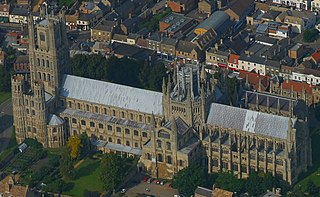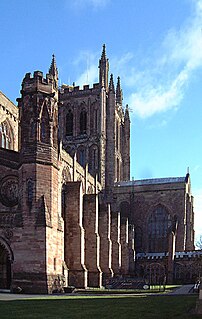Gruffudd ap Rhys was Archdeacon of Brecon from 1345 until 1366. [1]
Gruffudd ap Rhys was Archdeacon of Brecon from 1345 until 1366. [1]
John Chishull or John de Chishull was Lord Chancellor of England, Bishop of London, and Lord High Treasurer during the 13th century. He also served as Dean of St Paul's.

Hervey le Breton was a Breton cleric who became Bishop of Bangor in Wales and later Bishop of Ely in England. Appointed to Bangor by King William II of England, when the Normans were advancing into Wales, Hervey was unable to remain in his diocese when the Welsh began to drive the Normans back from their recent conquests. Hervey's behaviour towards the Welsh seems to have contributed to his expulsion from his see. Although the new king, Henry I wished to translate Hervey to the see of Lisieux in Normandy, it was unsuccessful.

Richard Swinefield was a medieval Bishop of Hereford, England. He graduated doctor of divinity before holding a number of ecclesiastical offices, including that of Archdeacon of London. As a bishop, he dedicated considerable efforts to securing the canonisation of Thomas de Cantilupe, his predecessor, for whom he had worked during his lifetime. Active in his diocese, he devoted little time to politics. He was buried in Hereford Cathedral where a memorial to his memory still stands.
Richard of Gravesend was a medieval Bishop of Lincoln.
Henry of Sandwich was a medieval Bishop of London.
Richard Gravesend was a medieval Bishop of London.
Fulke Lovell was a medieval Bishop of London-elect.
Isaac Singleton was an Anglican priest.
The Archdeacon of Salop is a senior ecclesiastical officer in the Church of England Diocese of Lichfield. The incumbent is Paul Thomas.
David FitzGerald was a medieval Bishop of St David's in Wales.
William Witham was incumbent at St Marylebone until 12 November 1454, when he exchanged the office for that of Archdeacon of Stow. He was then Archdeacon of Leicester, Dean of Arches and Dean of Wells until his death before 1473.
The Archdeacon of Brecon is a senior ecclesiastical officer in the Church in Wales Diocese of Swansea and Brecon. The archdeacon is the senior priest with responsibility over the area of the archdeaconry of Brecon, which comprises the five rural deaneries of Brecon, Builth, Crickhowell, Hay and Maelienydd.
The Archdeacon of Bangor is the priest in charge of the archdeaconry of Bangor, an administrative division of the Church in Wales Diocese of Bangor. In 1844, the Archdeaconry of Bangor was combined with the Archdeaconry of Anglesey to form the Archdeaconry of Bangor and Anglesey. The archdeaconry comprises the seven deaneries of Archlechwedd, Arfon, Llifon/Talybolion, Malltraeth, Ogwen, Tyndaethwy and Twrcelyn.
This is a list of the archdeacons of St Asaph. The Archdeacon of St Asaph is the priest in charge of the archdeaconry of St Asaph, an administrative division of the Church in Wales Diocese of St Asaph. The archdeaconry comprises the five rural deaneries of Denbigh, Dyffryn Clwyd, Holywell, Llanrwst/Rhos and St Asaph.
William Spridlington was Dean of St Asaph from 1357 until 1376; and then Bishop of St Asaph from 1376 until his death on 9 April 1382.
Llywelyn ap Madog was Dean of St Asaph until 1357 ; and then Bishop of St Asaph from then until his death in 1375.
John Hills, D.D. was a priest and academic in the late 16th and early 17th centuries.
The Venerable Brian Higden, D.D. was an Anglican priest in the late 16th and early 17th centuries
Gruffudd ap Rhys